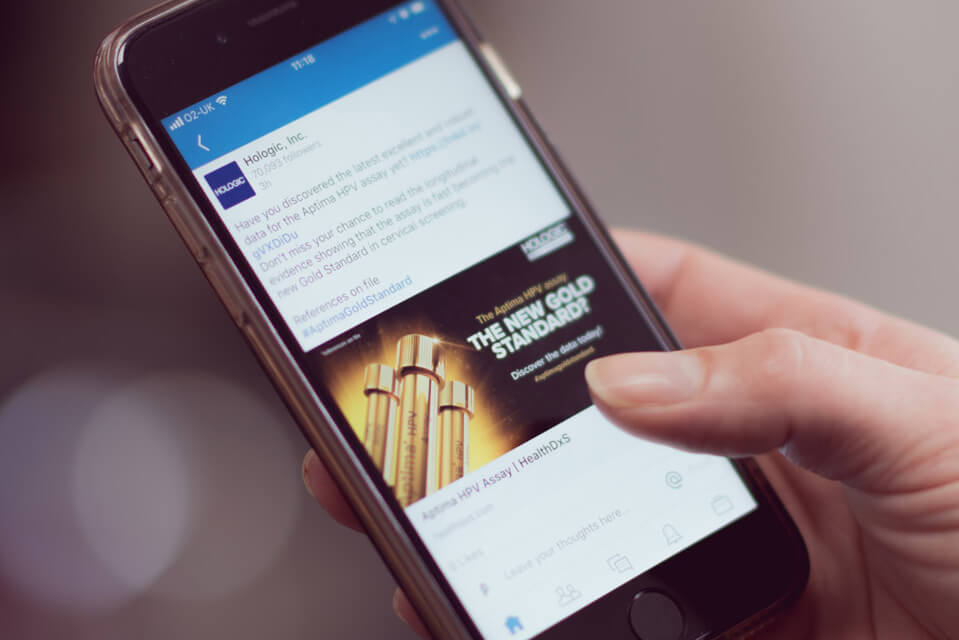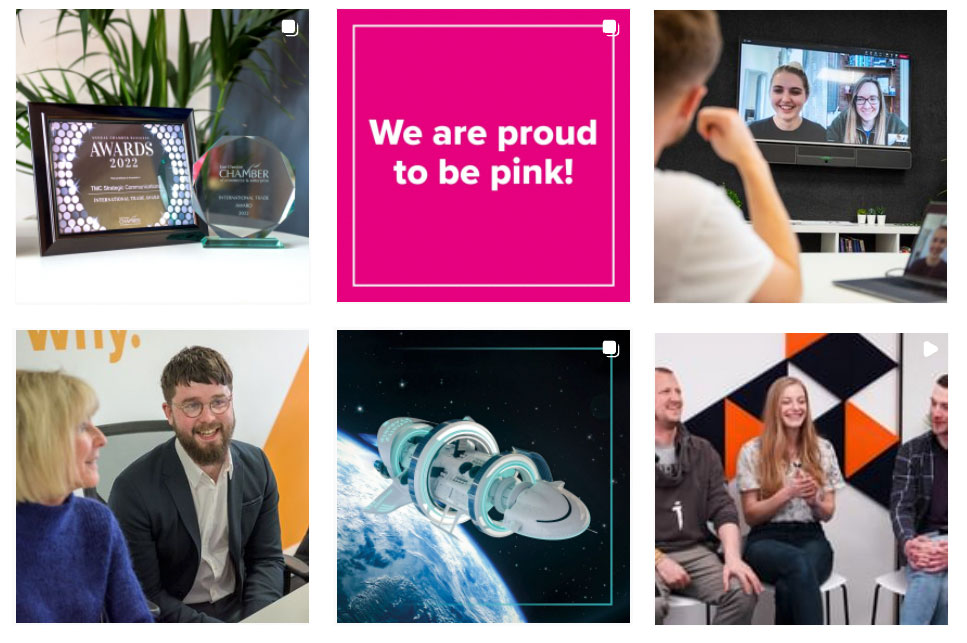
When it comes to developing a social media strategy, it can often feel a little overwhelming – especially for those who are not personally active on the platforms.
Taking into consideration that more than half the world’s population now uses social media on a regular basis (that’s around 4.48 billion people!), it’s clear that these platforms provide huge opportunity when used as a marketing tool for any business. In fact, 76.1% of internet users aged 16 to 64 use social media platforms for brand research.1 This shows how social media benefits companies and, without it, your company may be missing out on vital leads and customers.
With so many social media channels to choose from, making an informed choice can feel difficult. However, making sure that you adopt platforms that align with and support your business’ strategy can help you to prioritise your resources and ensure success.
Which Social Media Channel Should I Use for my Business?
Largely, this depends on what your business values and the audience you are targeting. Therefore, it is important that you:
- Define your social media goals. Do you want to generate leads, expand your reach to new audiences, or maybe create brand awareness?
- Find your audience. Which platforms are they most active on? Conduct audience research to narrow down the platforms they use by gender, demographics, interests etc.
- Identify the type of content you want to create. Are you looking to share long-form content such as blog posts and articles, or are you primarily focusing on design-based content and photography? Will you be sharing videos, podcasts or live streams?
Discover our beginner’s guide to Social Media Channels, to help you find the right fit for your business.
Twitter is built on creating instant connections, sharing ideas and partaking in spontaneous conversations. With just 280 characters available per post, short and snappy tweets are those that work best on this platform.
Our favourite features include the ability to share images, videos and gifs, create polls and join spaces.
Great for: Expanding your network and engaging new audiences, by getting involved and starting relevant conversations. Twitter is the most ‘open’ channel and allows you to manually search for specific keywords and hashtags. Timesaving apps such as Tweetdeck also also allow you to set up streams of keywords/hashtags that you can regularly check in with, without the manual search. By using relevant hashtags within your tweets, you also have the opportunity to draw users to you.
Not so great for: If you’re paying for adverts on Twitter it’s worth noting that their placement sits within the main timeline, which could prevent them from standing out. In contrary to their objectives, the main way users tend to notice promoted tweets are when they’re completely obscure and disrupt their usual stream.
How often should you post: One of Twitter’s key selling points is that it’s an on-going stream of activity, so allows users to post regularly throughout the day (just make sure that posts are spread out and you don’t continually repeat content!).
Tip: Use the ‘GIF’ keyboard that is integrated into Twitter to really help your posts stand out!
Whilst you can meet each of the team via their very own bio page, we decided to bring the TMC spark to life with something new…
Learn more about the TMC Team here https://t.co/2WdAxbNe3k pic.twitter.com/ERSn2AlXrq
— TMC (@wearetmc) April 8, 2022
Facebook has the largest number of users and is arguably one of the most influential. On average, users spend around 19.6 hours per month on Facebook.2 It is primarily used as a personal network, however it is also incredibly useful for business and professional outreach.
Our favourite features include the ability to share images, videos and gifs, create polls, live stream, check in to places and raise funds through a donation post.
Great for: Customer service and reviews. If you’re a local business or restaurant, then Facebook can be a great asset for users to naturally showcase your services – without you even trying! Facebook also has the highest conversion rate for sponsored adverts, which is useful when you have budget at your disposal. The versatility of ad targeting is also a standout feature amongst other platforms. Paid adverts on Facebook can be created through a variety of templates, so always best to research the most appropriate type to achieve your goals.
Not so great for: Organic reach. With Facebook becoming increasingly difficult to reach users for ‘free’, you’ll find that organic posts simply won’t reach everyone who ‘likes’ your page. Take a look at our post on Social Media Algorithms to find out more.
How often should you post: We would recommend posting only once per day, ensuring that content is relevant. Facebook dislikes ‘content for content’s sake’ so avoid posting unless you have something of value to share.
Tip: Run a generic ‘page like’ advert away from your timeline to keep a constant stream of users aware of your business.

Instagram is built around visual content. It began life with a focus on photography and visual editing, but in recent years has started to lean more towards creating engaging short-form video content alongside photos.
Our favourite features include the ability to share images and videos, create 24hr stories (saving them to highlights for future reference) and live streams. The stories feature allows you to add polls, question boxes, share links, tag locations or users, quiz boxes, donation links and more.
Great for: Visually showcasing your work or products. It also gives an engaging insight into any ‘behind the scenes’ workings of your company. Social users are incredibly nosey characters and love to see the ‘human’ element behind their favourite brands. The story feature is ideal for content that isn’t visually ‘worthy’ of your main profile, and shows a little more personality! In contrast, the reels feature allows you to create short videos that sit in their own feed, expanding your brand’s visibility.
Not so great for: Long-form written content such as blog posts, news articles and whitepapers. Also to note, when using Instagram as an influencer network to advertise your products or services, be aware of inflated follower numbers and engagement. Whilst this type of advertising can be beneficial for growing a brand, it can be tricky if you are working with influencers to spot the authentic ones with real engagement. A higher following doesn’t always equal higher levels of engagement! We recommend using a web service such as Social Blade to investigate the authenticity of your potential advocates.
How often should you post: Once a day on your feed, if possible. If utilising stories, these can be posted throughout the day. Similar to Twitter, there is a constant stream of content that is shown to users. When first starting out in the world of Instagram, it’s worth experimenting with the types of posts you publish, to establish what works well with your audience.
Tip: Make sure you use as many relevant hashtags as possible – you’re permitted up to 30. Users are active at monitoring and engaging with content and discover new points of interest through hashtag streams.
LinkedIn is a social networking platform for professionals, with content generally geared towards business and career development, recruitment, and networking. All businesses should aim to have a LinkedIn profile that provides key information about their services/products alongside contact details.
Our favourite features include the ability to share photos, videos, create polls, share job descriptions and add documents or articles.
Great for: B2B audiences and generating new sales leads. LinkedIn houses a network of professionals, where you can add existing contacts in your database, or seek out new ones. If you’re a business that serves several different sectors, you can also extend your main LinkedIn Business Page with ‘Showcase’ pages to really make your services stand out. The ‘audience reach’ on LinkedIn posts can also be impressive, in comparison to other social networks.
Not so great for: Recreational or casual posts. Whilst some personal and informal posts do well, overall LinkedIn has a higher level of formality in comparison to others – essentially a digital workplace. Spend a few minutes scrolling on LinkedIn and it won’t be long until you come across the phrase ‘LinkedIn appropriate’. Many users find that LinkedIn should only be used for a certain tone or type of post.
How often should you post: LinkedIn recommends that for business pages you should post once per day. However, this can be difficult when sticking to strictly business content. If in doubt, it’s probably best not to publish. Quality over quantity here.
Tip: Interact with as many other users as possible. Comment and share on articles of interest and join the discussion.

TikTok
TikTok is one of the newest, and fastest growing platforms. It has quickly become a strong contender for audience reach with over 700 million active users per month! These users are primarily a younger demographic, however the platform’s popularity is growing across all ages. With a potential ad reach of 884.9 million on Tiktok3, it should be something businesses are looking into.
Our favourite features include the ability to share videos and live streams.
Great for: Short-form video content that entertains or educates. TikTok is filled with content from all genres and is mostly informal. Great for behind-the-scenes posts or ‘how-to style’ snapshots, along with fun dances and silly videos.
Not so great for: Businesses that want to convey a more serious brand image, or long-form content.
How often should you post: Posting a few times a week at least would be beneficial, to make use of the ever-changing trending music. Trends move quickly on TikTok, so you need to be ahead of the curve to take advantage of a higher reach.
Tip: Make note of the style of video you see and the music you hear as you scroll the feed. Using the current trending music on your videos and creating similar ‘popular’ content will help to improve your reach.
YouTube
YouTube is the second-most popular platform, after Facebook (not surprising as it’s owned by Google!). Whilst it doesn’t seem as obvious a choice for a social platform, YouTube has over 2.29 billion registered users and with video content being a fast-growing medium in content marketing, it makes sense to utilise this platform.
Our favourite features include the ability to share videos and live streams.
Great for: Video content that entertains or educates, you will find all genres on this platform. YouTube is one of the largest search engines after Google – the question and answer format ensures videos are served for many search queries, so master your SEO and you’ll achieve a strong reach.
Not so great for: The reporting gives you little insight into visitors behaviour and interaction, so it can be difficult to track momentum. It can also be more competitive due to YouTube’s recommended videos that appear with each upload.
How often should you post: Between 1-3 times per week is ideal when you’re starting out and trying to capture an audience. A regular schedule can help to raise your channel in the algorithm.
Tip: Build up a content library of batched content so you’re not rushing each week to get new ideas and new content out.
Great for: Bringing traffic directly to your website. Unlike other social networks, Pinterest isn’t that interested in connection people to other people. Pinterest is more interested in sharing visual goodness that drives people to your site. You will also find that Pinterest increases the longevity of your content, and users will actively share older posts for years after creation!
Not so great for: reaching male audiences. Pinterest is a female dominated platform. If your product is tailored to men, you will be better off concentrating your efforts elsewhere. With this in mind, you’ll find that recipes, crafts and fashion posts tend to do well in comparison to other content.
How often should you post: If you’re posting from your own website, you are only permitted to ‘pin’ a certain number of images in one go. You can, however, post as many times a day as you like from various sources! As each image is different, but the theme stays loosely the same, you will find that followers welcome an active user.
Tip:
Look at creating collaborative boards with online communities. You can set up a communal board where people with the same interests can actively pin and increase the visibility of both your account and theirs.

Choosing the Right Social Media Platform
Be selective with your presence on social media. With different functions and features available across each platform, identify what your business needs and investigate your target audience before making a decision. It is better to put your focus on a few platforms and master them, than try to use every single platform and spread yourself too thinly.
Need help with your social marketing strategy? Contact us to find out more about how our strategic communication plans can help your business.
Follow TMC here:
Source: The Global State of Digital 2022′ – https://www.hootsuite.com/en-gb/resources/digital-trends
- 76.1% of internet users aged 16 to 64 use social media platforms for brand research – Page 106
- Users spend around 19.6 hours per month on Facebook – Page 105
- Potential ad reach of 884.9 million on Tiktok – Page 157
Share this
Find out more about the services we offer
and let’s work together to grow your business
Strategy
Creating market engagement.
Explore how our range of Strategic Solutions create stronger connections and actively engage your audiences.
Identity
Visually reinforcing your brand.
Discover how our Creative and Branding services enhance your Identity through compelling and arresting content.
Technology
Creative solutions & innovation.
Let us show you how we deliver intelligence led digital solutions that bring your brand to life whilst improving visibility.
